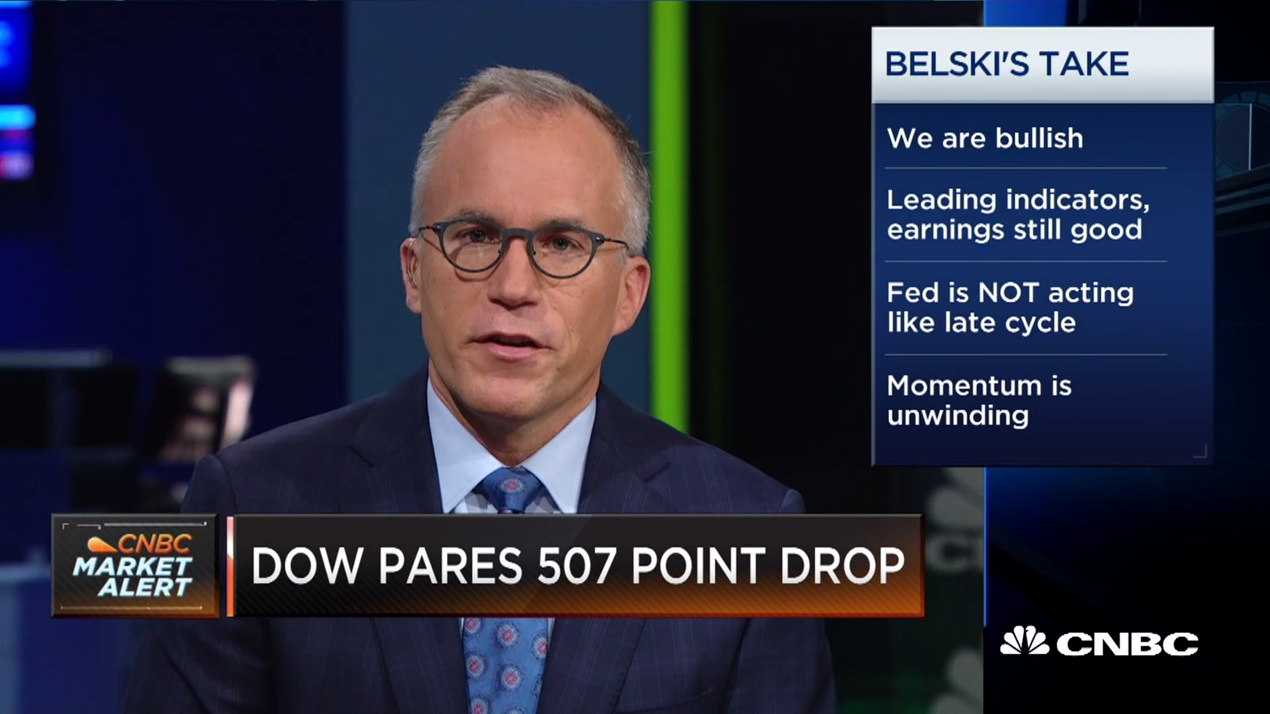Key takeaways
- In the US, we believe peak levels of growth are behind us and expect to see slowing in the second half of 2019.
- Outside the US, there are also signs of softening growth.
- Inflation is likely to increase somewhat, but we do not believe that wage inflation will be significantly passed through to consumer prices in 2019.
Global macro
In the US, we believe peak levels of growth are behind us, although we expect annual growth of around 2.75% to persist through the first half of 2019 before slowing. Fiscal stimulus is still having a positive effect on growth, but will likely wane in the second half of 2019. In addition, the positive financial tailwinds that have been driving the economy may turn more neutral as monetary policy continues to tighten. Therefore, while consumer spending will likely be additive to growth in the first half, as the boost from tax cuts winds down, the question is how much will the consumer want to spend thereafter? Consumption has grown at an unsustainably high level, in our view, over the last several quarters, driven by stronger consumer confidence and tax cuts. A meaningful slowdown in consumption could have negative implications for broader growth. These effects mean that risks to economic growth are higher in late 2019 than they have been in previous points in the cycle.
Inflation is likely to increase somewhat in 2019, supported by tariffs on goods prices. Aside from tariff-driven inflation, pressures are likely to be more subdued. However, labor prices are likely to continue their slow rise as employment markets tighten. We do not believe that wage inflation will be significantly passed through to consumer prices in 2019.
The combination of strong labor markets and strong growth make it very likely that the US Federal Reserve (Fed) will continue its slow hiking cycle through the first half of 2019. However, if the yield curve continues to flatten and financial conditions tighten, it might be more difficult for the Fed to hike twice in the second half of 2019.
The US Treasury market has undergone a significant correction, and valuations are now inexpensive relative to long-term fundamentals, in our view. However, large fiscal deficits will continue to cause the US Treasury to issue large amounts of debt. Increased supply combined with declining Fed purchases could create US Treasury volatility in the coming year.
US growth is attracting capital flows, and this is likely to continue until global growth paths begin to converge. In our view, this is likely to support the US dollar in the coming months. If there is a significant US slowdown next year, we believe it would likely be imported from China (not generated internally), if China is unable to ease itself out of the slowdown it is currently experiencing.
Outside the US, there are also signs of softening growth. In China, we have been penciling in lower-than-consensus 2018 economic growth since the start of the year. The current softness in economic momentum may be traced back to tightening regulations and deleveraging policies that took place in late 2017/early 2018, leading to a sharp slowdown in credit trends in mid-2018. Additional uncertainty has been generated by US trade policy. Chinese policymakers have begun to ease again in response to these developments in growth. The success or failure of this easing program will likely have major implications for global financial markets.
Europe is proceeding at a slower pace than we expected earlier in the year, as the effects of stimulus delivered in 2015 and 2016 fade. In addition, several risk events on the horizon are likely to act as headwinds to both growth and markets: Italian politics and budget concerns, US-Europe trade tensions and Brexit uncertainty. On top of that, the European Central Bank is likely to begin its hiking cycle sometime in the fourth quarter of 2019. Due to these growth and political factors, we do not expect core European interest rates to move too far from current levels in the next six months.
Investment grade
The coordinated global growth conditions of 2017 appear to have softened in 2018 and may result in further economic dispersion across the developed world in 2019. Despite this headwind and the threat of tightening monetary conditions, corporate fundamentals continue to remain resilient. As a result, we expect corporate credit to outperform comparable sovereign debt due to the additional income available to corporate investors. Corporate spreads should also provide some buffer from the potential for higher interest rates.
The growth of debt markets, especially the BBB component of the US corporate space, is drawing considerable attention as a potential source of risk. While a combination of merger and acquisition (M&A) activity and credit migration has expanded the lower quality portion of the investment grade market, corporate leverage has tended to decline following such events. The M&A pipeline is the lightest we’ve seen in recent years, and investor surveys show a desire for US companies to de-lever.
We remain positive on corporate credit. However, the risk of unanticipated monetary tightening or a deceleration in global growth could result in deteriorating fundamentals. The number of “known” potential risks — from the impact of tariffs to geopolitical issues — is on the rise, and any one of them could alter the trajectory of the current cycle. We also continue to monitor secular trends in technology, which have the potential for far-reaching impacts across industries such as retail and transportation. We believe sector allocation and security selection resulting from a sound credit process will be as critical in 2019 as it was in 2018.
High yield
Despite market fears of slowing economic growth, high yield has historically fared well in moderate growth environments. While there is some fear in the marketplace that corporate earnings have hit a near-term peak, fundamentals overall are robust enough for companies to generate free cash flow and reduce leverage. Reduced leverage generally means lower default risks, which can lead to tighter credit spreads. Negative returns in high yield are generally driven by recessions, as company earnings decline and defaults increase. We do not believe we are in that environment today, as the Fed and the European Central Bank have elongated the business cycle. Their actions have benefited credit markets and afforded many companies to reduce leverage.
As high yield investors, we are aware of duration risk and the volatility associated with interest rate movements. There are three reasons why rising rates by themselves may not be bad for most high yield bonds.
- Normally, rates rise as the economy is expanding, which typically generates more profits for most companies and a greater ability of companies to service their debt.
- High yield bonds may offer call protection. When rates rise, issuers often refinance their debt before rates go higher. If an issuer refinances its debt before maturity, it normally pays a penalty (call price) that varies between 102 and 105. This pre-payment penalty is added to the returns of the high yield bond.
- The duration of high yield bonds is typically lower compared to investment grade bonds due to the comparatively short maturities and high coupons of high yield bonds.
While history demonstrates that recessions are a negative influence for high yield, we do not see an immediate cause for concern given the overall health of the US economy, the gradual pace of Fed tightening, and robust fundamentals among many high yield issuers.
Structured
Agency mortgage backed securities (MBS). The primary driver of Agency MBS performance in 2019 will likely come down to the simple economics of supply vs. demand. The recent trend higher in interest rates should dampen mortgage supply to some degree, but we still expect a healthy $225 billion of net supply to hit the market next year. That amount of supply is in line with historical norms, and one which the market can easily absorb. The problem is, the supply impact felt by the market may be nearly double that amount. The Fed has stopped reinvesting pay downs from its USD1.7 trillion mortgage portfolio, so prepayments that had previously been reinvested are now effectively increasing supply to the rest of the market. While nominal Agency MBS spreads have increased roughly 20 basis points in 2018 to accommodate this excess net supply,1 we believe the market may need to cheapen by another five to 10 basis points, at current volatility levels, to clear the excess net supply and stabilize.
Residential mortgage backed securities. Although recent housing data reflect some weakness in construction and sales activity along with affordability constraints, the limited supply of homes against the backdrop of a strong labor market underpins our positive outlook for home prices and borrower performance. Issuance volumes continue to fall short of legacy paydowns, resulting in heavy competition for floating rate and limited duration assets prevalent in the sector. Nevertheless, the flatness of the credit curve warrants a measure of caution with respect to below investment grade securities, with limited room for further spread tightening in these credits, in our view. We believe highly rated classes, on the other hand, offer compelling spread pickup versus other fixed income credit sectors. While we are cautious about non-investment grade spreads, our concerns about the ultimate credit quality of lower-rated classes remain limited. As short-term interest rates continue to move higher, we see attractive opportunities in floating rate securities, including single-family rental securitizations and moderately seasoned Credit Risk Transfer bonds issued by Fannie Mae and Freddie Mac. Much of the growth in residential credit issuance will likely be linked to non-qualified mortgages, as the investor base broadens and the sector continues to mature.
Asset-backed securities (ABS). As the US economy approaches late cycle, current strong fundamentals are expected to gradually move toward normalized levels in 2019. This remains a positive factor for the consumer and underlying ABS collateral performance. As the Fed continues to tighten and the yield curve flattens, shorter-term ABS should remain in high demand. As a result, we expect projected gross ABS supply to be easily absorbed by the market. While relative attractiveness of ABS versus corporate bonds has diminished somewhat, we are still finding attractive areas of value for reasonable yields and short maturity profiles. Additionally, ABS offer diversification from corporate bonds.
Commercial mortgage-backed securities. We expect commercial real estate rent growth and property price appreciation to continue, albeit at a slower pace as new supply dampens space absorption. In the retail property sector, we expect growth in e-commerce to remain a headwind. On the positive side, lending conditions remain very accommodative across property markets, despite slightly tighter credit standards and higher rates. Additionally, we expect modest new issuance volumes to be easily absorbed by investors. With a neutral outlook on spreads and a flattened credit curve, we prefer slightly seasoned credits that benefit from embedded property price appreciation and contracting spread duration. As we progress further into the real estate cycle, we believe commercial real estate debt that offers attractive carry and benefits from appreciation that has already occurred will become increasingly more attractive.
Global liquidity
Invesco Global Liquidity expects US money market yields to increase in 2019, as the Fed continues to push monetary policy rates higher. Even though the Fed has increased policy rates for three years in a row, current rates are considered to be in neutral territory and many market participants believe the Fed has more room to remove policy accommodation if needed. We expect at least two rate hikes in 2019. As a result, yields on money market securities and low duration investments may become even more attractive on a relative basis if the US Treasury yield curve maintains its five-year flattening trend. This may continue to drive asset flows into money market funds, ultrashort bond funds and exchange-traded funds (ETFs). We expect abundant supply of short-term US Treasury securities and demand for high quality assets to keep credit spreads at the lower end of recent ranges. Risks to credit spreads could come from an unexpected weakening of the US economy or late-cycle hints of a recession on the horizon.
Emerging markets (EM)
We believe EM growth has peaked and expect it to moderate into 2019. China, in particular, is slowing, although in a measured, managed way. Targeted easing will likely mitigate China’s growth-related risks, but we cannot rule out periods of financial market disruption as authorities seek broad deleveraging. We expect the US dollar to weaken in 2019 as global growth re-couples, which should lend support to EM and commodities as it fosters capital inflows and improved terms-of-trade. That said, there are likely to be periods of US dollar strength and higher US yields, which could lead to bouts of market volatility. Escalation in global trade tensions may also continue to test markets. We expect volatility to rise in general in 2019 as major central banks gradually removal extraordinary monetary accommodation.
Risks to our view include a resurgence in US inflation, which would likely prompt policy tightening beyond what is priced-in, leading to a sharp deterioration in financial conditions via strengthening in the trade-weighted US dollar. Also, concerns related to Chinese growth may move to the fore, placing downward pressure on industrial commodities and broader risk sentiment, beyond concerns relating to trade disputes.
EM asset selection has become of paramount importance, particularly in the aftermath of a heavy election period in Brazil, Mexico and Turkey, and in advance of upcoming elections in Argentina and Indonesia in 2019. Sanctions risk is also elevated in Russia and, to a lesser extent, Turkey. EM currencies remain highly sensitive to US funding conditions, but scope for US dollar stability in 2019 will likely lend support, given the extent of the EM currency sell-off in the second and third quarters of 2018, and as US growth moderates. We tend to favor the currencies of commodity-producing countries, given valuations and the yield advantage. Although on the rise, we expect EM inflation to remain low, providing scope for the inflation risk premium in the longer end of selected EM yield curves to continue to compress. As with EM currencies, we favor commodity-producing local rate markets.
European fixed income
European economic growth moderated in 2018, from above-trend levels to a more sustainable pace, in our view. In 2019, we believe Europe’s economic backdrop of robust growth, subdued inflation and accommodative monetary policy will likely support European fixed income. The forward guidance provided by the European Central Bank (ECB) is well documented, and although quantitative easing is drawing to a close, we do not expect interest rate hikes to occur until the fourth quarter of 2019. We believe the ECB’s growth targets are overstated, but we are not concerned that this will have a material impact on the broader European fixed income markets. Europe is earlier in the credit cycle than the US, with stronger corporate de-leveraging trends underway and more conservative discretionary cash flow behavior, which is generally positive for bondholders.
Our main concerns for the region revolve around political uncertainty.
- Italy’s political situation remains the biggest unknown. However, while the situation continues to evolve, we assign a very low probability to Italy leaving the euro. As we move into 2019, we expect friction over Italy’s budget deficit to continue to weigh on investor sentiment, likely creating bouts of market volatility but also presenting opportunities. We believe valuations are attractive in Italy, but we remain concerned about the political outlook and the country’s long-term debt sustainability, especially in light of its low growth prospects and the removal of ECB monetary stimulus.
- Our base case for Brexit is that a deal will be agreed upon at the expense of a longer transition period. Accordingly, we believe current valuations present opportunities in certain parts of the UK corporate bond market, namely among issuers with a strong international presence that may mitigate the potential growth challenges of a hard Brexit.
Overall, we believe solid European growth, low inflation and accommodative monetary policy are supportive of riskier assets in the region. That said, as the ECB pursues its path of policy normalisation and as European — and global — political uncertainty remains elevated, we believe caution is warranted.
US municipals
Much of our 2019 outlook for the municipal asset class hinges on our expectations for new issuance. Total new issuance in 2018 looks likely to fall below previous years due largely to the elimination of advance refunding issuance under the Tax Cuts and Jobs Act (TCJA) of 2017. This change caused issuers to bring issuance forward into 2017, resulting in reduced 2018 supply. While the repeal of advance refunding issuance directly affected the tax-exempt market, it remains readily available (though rarely used) in the taxable municipal market. This may add to potential issuance in 2019. However, even with this possible boost, we do not expect municipal supply to exceed 2018 levels by much — a net positive for municipals, in our view.
On the demand side, we expect individual investors to play a larger role in the municipal market going forward. Their participation may increase during the early 2019 tax season, as tax cuts under the TCJA potentially end up smaller-than-expected. This may be especially true for investors in high-tax states. Municipal securities should also continue to offer diversification benefits, since they have historically exhibited low correlation to other asset classes, such as equities, corporate bonds and US Treasury securities.
With the US midterm elections behind us and the Democratic win in the House, we believe “tax reform 2.0” is less likely. Infrastructure spending, one of the only areas with bi-partisan support, may see a rise in 2019, but we believe it is unlikely. Rather, we believe Democrats will likely pursue infrastructure as part of their 2020 campaign platform, with more immediate resources put toward health care and immigration policy. Once decisions are made on infrastructure, we expect funding to be accessed via the municipal market. However, we expect the pace of issuance to be measured.
Indian fixed income
The Indian fixed income market cheapened in 2018 due to fears of a rate hike amid a rise in domestic inflation and a depreciating rupee. However, we expect a rebound in 2019 as headline inflation likely remains under 4% for most of the year and expectations of future rate hikes, which were previously priced into bond yields, potentially retreat in the coming months.
The rupee’s decline has also been an important driver of upward pressure on bond yields in 2018. Trade war concerns, higher oil prices leading to a higher current account deficit and general risk aversion toward emerging markets all pressured the rupee lower in 2018.
We expect some recovery in the rupee as oil prices stabilize and if “risk-off” sentiment subsides in 2019. The contraction in the differential between Indian and US inflation may also help limit the rupee’s long-term depreciating trend. Additionally, the liquidity-enhancing measures of the Reserve Bank of India, through open market operations (gilts purchases), have resulted in net positive demand for gilts. Overall, we expect 2019 to be additive to bond performance due to the positive combination of a retreat in bond yields and consolidation in the rupee.
Asian fixed income
We are constructive on Asian fixed income on the back of stabilizing Chinese growth and our outlook for increased foreign direct investment in the region. Geopolitical risks will likely remain on the forefront, however, as the US is poised to increase tariffs on Chinese exports in 2019 and impose additional tariffs. Indian and Indonesian general elections are slated for the first half of 2019, which are bound to generate headlines and potential volatility.
We are sanguine about China, as policy easing measures appear to support economic growth after a deceleration in the beginning of 2018, attributed to weakening domestic consumption and the impact of de-leveraging. Improved liquidity in the system is expected to boost economic growth and neutralize part of the negative impact of trade disputes. Looking to 2019, we favor bonds with short maturities and attractive yields issued by solid credit quality names. We are monitoring two variables closely: 1) the extent that increased liquidity flows into the private sector and 2) the USD-renminbi exchange rate. We are especially watching Chinese issuers who are more vulnerable to the exchange rate’s performance.
Outside of China, we favor markets that are likely to benefit from increased US and Chinese direct investment. The Chinese government is expected to put significant capital to work in the region through the Belt and Road Initiative, which would be positive for recipient countries. The US and other countries are also likely to increase investment in the region as a counterweight to China’s program through initiatives like the US-led Indo-Pacific Alliance with India and Mongolia and via the International Development Finance Corporation, which invests in developing country projects. We are watching two key risks: 1) environmental, social and governance (ESG) factors to avoid potential disruption caused by social unrest, corruption and/or environmental disasters, and 2) potential financial distress that could be caused in some Asian countries by a strong US dollar, especially those with substantial US dollar debt relative to their GDP.
This post was originally published at Invesco Canada Blog
Copyright © Invesco Canada Blog













